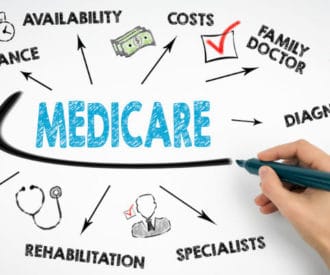
Seniors covered by Medicare have been hit hard by sharply rising prescription drug costs. HealthMarkets explains the 3 steps that Medicare is taking to reduce these costs and shares 3 resources to help older adults save money on prescription medications now.
Over 70% of all Medicare recipients are enrolled in Medicare Part D prescription drug coverage plans.
With so many Americans using prescription drugs, the rising cost of prescription drugs is a critical issue. And in recent years, seniors have been spending more on drugs, but getting less for their money.
The government has responded by creating 3 initiatives to lower prescription drug costs. Seniors can also use 3 existing resources to help reduce the cost of their medications.
High out-of-pocket prescription drug costs hit seniors hard
A report from Health and Human Services found that Medicare beneficiaries filled fewer prescriptions for expensive brand-name drugs, but ended up spending more on those meds due to rising drug prices.
This is a big problem for the millions of seniors who have relied on Medicare Part D to afford their medications for chronic conditions like diabetes.
The report also says that people who need brand-name insulin, cholesterol drugs, and asthma inhalers are being hit the hardest by rising out-of-pockets costs.
For example, Novo Nordisk, one of the biggest producers of diabetic medicine, lists the wholesale price of its Levemir long-acting insulin at over $300 for a single vial.
The big question is: what is Medicare doing to keep health insurance affordable for its customers?
Government and CMS response: 3 initiatives to lower drug costs
The Center for Medicare and Medicaid Services (CMS) has announced its action plan to address brand-name medication prices with 3 targeted initiatives.
The good news is that Medicare enrollees will start benefiting from these plans in 2019.
1. Inclusion of generic drugs
Because brand-name prescription drugs are the most expensive, CMS will allow insurance companies to include low-cost generic alternatives on their lists of approved drugs.
CMS also intends to give beneficiaries more options when it comes to buying medications. Medicare insurers will have to allow all interested pharmacies the opportunity to participate in their networks.
2. Decreased generic drug expenses
CMS will also decrease the maximum amount that beneficiaries in lower income brackets are responsible for paying.
This change is specifically for biosimilar medicines – cheaper imitations of brand-name products that are reproduced by a different company once the original manufacturer’s patent has expired. (These drugs are safe if approved by the FDA.)
3. Wider variety of Part C coverage
CMS is also removing restrictions on the variety of Medicare Advantage (Part C) plans that an insurance company can offer.
Medicare Advantage (Part C) plans are sold by private insurance companies and include all of the same benefits as Original Medicare (Parts A and B).
The difference is that Medicare Advantage plans usually include prescription drug (Part D) coverage and may also include additional coverage like vision, hearing, and dental.
3 ways to lower prescription drug costs now
In addition to those new initiatives, there are also 3 helpful resources that Medicare beneficiaries can use right now to reduce the high cost of brand-name prescription drugs.
1. Pharmaceutical assistance programs
Some pharmaceutical companies offer assistance for specific drugs they manufacture. Use this tool to search for assistance programs by the name of the drug.
2. Medicare Extra Help
For people under a certain income level with limited assets, Medicare’s Extra Help program helps pay the costs of Medicare prescription drug coverage.
Those who don't qualify for Extra Help might be able to qualify for state or other programs that can help cover their prescription drug costs.
3. Benefits programs
Seniors on fixed incomes with limited resources can also explore national and community-based benefits programs that help with the cost of medical care.
Medicare.gov lists three helpful resources:
- BenefitsCheckUp
- National Patient Advocate Foundation
- National Organization for Rare Disorders
Recommended for you:
- How Seniors Can Get Help Paying for Prescription Drugs
- 5 Ways to Afford Prescriptions in the Medicare Donut Hole
- Benefits Programs Help Pay for Caregiving Expenses
Guest contributor: Michael Z. Stahl serves as Executive Vice President of HealthMarkets – one of the nation’s largest independent insurance agencies in the Medicare, individual, and supplemental health, life and small group insurance markets. He has a B.S. in Economics from The Wharton School, University of Pennsylvania, and holds the chartered property casualty underwriter (CPCU), associate in insurance accounting and finance (AIAF), and associate in reinsurance (ARe). An avid Kansas City Royals fan, he lives in Dallas with his wife and children.
Image: Complete Home Care
This article wasn’t sponsored and doesn’t contain affiliate links. For more information, see How We Make Money.
[optin-monster slug=”yxbytm35zhsdfopnw7qk”][optin-monster slug=”jvhyplxmb4umsjazxecn”]
About the Author
HealthMarkets
Michael Z. Stahl is the executive vice president and chief marketing officer of HealthMarkets, one of the largest independent health insurance agencies in the U.S. that distributes health, Medicare, life and supplemental insurance products from more than 200 insurance companies. Stahl holds the chartered property casualty underwriter (CPCU), associate in insurance accounting and finance (AIAF) and associate in reinsurance (ARe) designations, and earned a bachelor of science in economics from The Wharton School at the University of Pennsylvania. He lives in Dallas with his wife and four children.




